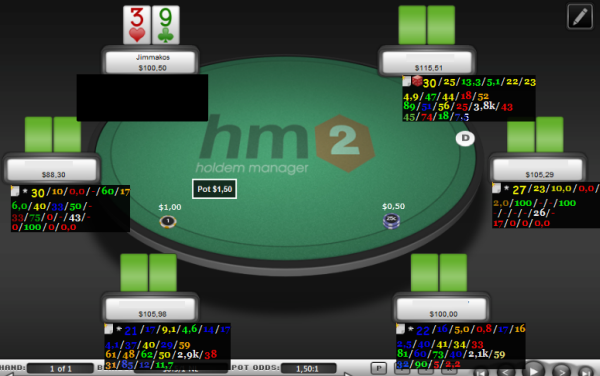A poker HUD, or Heads-Up-Display, is extremely useful in beating your opponents when multitabling your favorite poker room. Setting your HUD correctly will lead you to identify bad players quicker and avoid regulars who have an advantage against you.
Color-coding the poker stats you have at your disposal will increase the HUD’s effectiveness and hopefully your winrate. What is the use of displaying numerous of statistics if we don’t know their meaning, or how we should respond and adapt our playing style?
By following some basic rules and spending a little time into color-coding the stats in your favorite poker tracking software will definitely make an impact on your game and possibly even lead to adding one or two more tables!

I have been a customer of Poker Tracker since 2006 but I use Holdem Manager 2 nowadays. I have also applied the HUD that Leak Buster offers with the subscription but added some additional stats. After color-coding all those stats, it’s now easier to find opponents’ leaks and exploit their mistakes. Let’s see some of those.
Before we begin I need to explain the stats you see in my HUD.
- The first line shows VPIP/PFR/3bet/4bet Range/OpenEP/OpenMP.
- The second line reads AF/Agg%/TurnAgg%/RiverAgg%/Foldto3bet.
- Third line is useful for continuation bets, as it shows FlopCB/FlopFold2Cbet/TurnCbet/TurnFold2Cbet/Hands/WonSD%.
- The bottom line includes TotalSteal/SBFold2Steal/BBResteal/Squeeze.
Any statistic that is shown in blue is in accordance with the average figure and usually the opponent doesn’t make a mistake there. Poker stats, that are shown in yellow or green, deviate from the average upwards and poker stats shown in orange or red deviate downwards. Therefore I look for exploiting those specific stats and adapt my strategy according to those numbers.

Playing against an opponent of these stats means I have to deal with a very aggressive player. He is opening a lot (30%) in general but even from early (22) and middle position(23), he is 3betting a ton (13.3), his aggression factor is obviously skewed upwards (4.9), he is double-barreling often (56) after continuation betting almost all flops (89) and he is not that strong at showdown.
Additionally he is usually stealing with a wide range (45), he defends a lot from the small blind and 3bets more often than usual from the big blind. He is also rarely folding on turn (25) when they double-barrel him.
Having all that in mind, the best strategy is to open up our range a little when in position against this opponent and call him down lightly. We also need to rebluff him occasionally and depolarize our range, trying to steal his blinds with value hands.
If we are out of position we should either tighten up or be ready to go to war by 4betting/bluffing often, but in position and having the initiative we should double-barrel – also known as firing a second continuation bet on turn – only with value hands and never try bluffing him out of the hand.

Comparing the previous opponent with the next will make you understand why we don’t want to play with regular players.
In this example we obviously have to deal with a reg. Notice how many of his stats in the HUD are color-coded blue! The minor edge we can find is probably on the turn where he fires a lot (60) but also folds a lot when confronted with a continuation bet (50).
One more mistake is that he folds a lot from the big blind and doesn’t resteal, so we should try stealing more when he is at the big blind and quickly fold all hands except premium ones when he 3bets from BB. In order to gain more edge against this reg, we need to analyze specific hands and take notes.

Finally, let’s take a look at a rather passive poker player. Here the HUD shows that the opponent has serious issues regarding continuation bets and aggression in general.
He is easily got off his hand as he goes to showdown only when he is strong (61) and while preflop his game is fine, his postflop one needs many improvements. He is very passive both at turn (19) and river (14) making him an excellent candidate to try out bluffs with total air.
When we face a continuation bet from him we should better continue only with our very strong and value hands, since we already know his hand is strong enough to let him bet into us. If we opened preflop and can’t shake him off his hand by the flop, we must double barrel as he is folding more often than average (67).
Concerning stealing, he seems to be stealing with good hands (24) so we need not to defend against him from the blinds. In the event of seeing him squeezing, we have to continue only with our top value range as he never tried squeezing in 830 hands!






